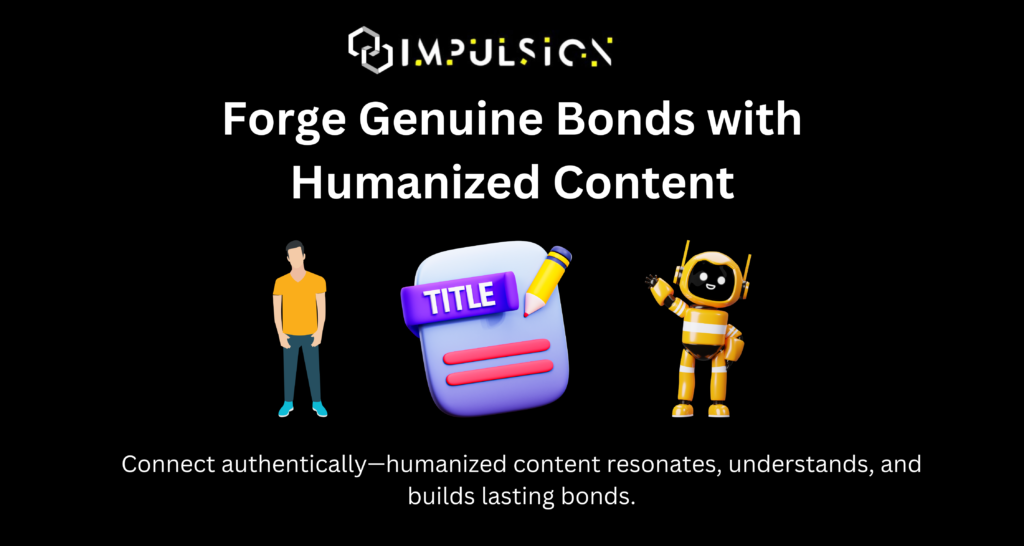
2023 marked a triumphant year for AI; all we heard was GPT and other trending AI platforms. Undoubtedly, AI can create accurate copies of content, but is AI solely the future of content? No, because AI can create content but can never replace the oomph that humanized content brings. There are innumerable human-written content; today, we will discuss the main ones.
1. Establish a connection with the audience

AI-generated content can be concise and appropriate, but it can never establish a connection with the audience. A human content creator is more capable of understanding the audience’s needs and personalizing them accordingly. For example, A content writer in the skin and hair care niche can cite personal examples or incidents where they faced any issue and some remedy or treatment worked for them, but an AI fails miserably in personalizing things. It follows the prompt, collects data from registered datasets, and produces sane redundant results without personalization. Thus, if you solely rely on AI-generated content, you may lose a connection with your audience.
Also, nobody loves reading something or interacting with a service that sounds robotic. Humanized content talks with the audience and directly brings solutions to their problems. It adds a natural appeal and authentic tone, which can set long-lasting connections with the raiders or buyers.
2. Assists in building trust and authority
Content that feels more “human” and less mechanical or robotic nurtures trust. We live in an era of misinformation, and in such an era, humanized content brings in genuine and transparent content, which helps establish credibility. When content generators present information in a natural manner and by recognizing uncertainties or biases where they exist, they assemble trust.
Humanized content also demonstrates empathy and addresses the audience’s concerns, fears, or aspirations. Thus, humanized content gives you an authoritative approach and also resonates deeply. When audiences feel understood, they are more likely to trust the source of the content. Brands focusing more on creating humanized content can build long-term and healthy relationships with their audience.
3. Helps promote engagement and inclusivity
Humanized content is more relatable and subjective and tends to engage audiences better. Content written by a human uses stories or everyday language that people can connect with. It’s like seeing parts of your life in what you read or watch. It makes it more intriguing and keeps people’s attention. When content sounds like a friendly chat, it’s easier to understand. It is helpful for only explaining hard topics, just like talking to a friend.
Writing clearly and simply, like for an eighth-grade reading level, helps more people understand the message. It’s not about making the content less smart but about making it clearer for everyone, including young people and those who don’t speak English as their first language. Humanized content works well in many forms, like blogs, videos, or podcasts. It can be changed to fit different media types, making it appealing to a wide range of people with different preferences for how they get their information.
4. Improves comprehension and emotional tone of the content
Humanized content makes things easier to understand. For example, instead of saying “photosynthesis,” we say “how plants make food from sunlight.” It is crisper, simpler, and clearer. Another example is using a story to explain gravity. Instead of technical terms, we might say, “Imagine dropping a ball. It falls because of gravity, like how apples fell on Newton’s head.” Stories make hard ideas easy to get. When talking about history, we might use a tale about a day in the life of a historical figure. It helps us feel like we’re there, making it easier to remember facts. In science, using everyday items in explanations, like comparing atoms to tiny solar systems, can turn complex concepts into familiar images.
Humanized content breaks down barriers, making learning accessible and enjoyable for everyone. It often uses stories to connect with the audience emotionally. For example, hearing a story about someone overcoming a challenge is more interesting and easier to remember than just facts and figures. This kind of storytelling can bring life to topics that might initially seem boring or too complex. It’s like remembering a good movie because it made you feel something. This emotional and deep connection in marketing can make customers remember and prefer certain products. In education, it can make lessons more engaging and grasping. In any area, connecting with people’s emotions makes your message more impactful and
The Bottom line
Humanized content helps you develop healthy connections and bring in more organic traffic, which converts into leads and, ultimately, a bigger client base. Thus, humanized content is the best way out if you want a genuine approach to marketing your services.
So, what is the conclusion about whether we should rely on AI or use humanized content? Look, relying on AI is not wrong, but not entirely; you can use it to aid your research and automate a few tasks, but you should not seek it to work for your content fully.
Meta Title- 2024 Guide:
The Power of Humanized Content in SEO
Meta Description:
Know why humanized content is key in 2024, balancing AI and human touch for authentic, engaging, and trustworthy online experiences!
 Exciting news! Get 15% off on digital marketing services
Exciting news! Get 15% off on digital marketing services